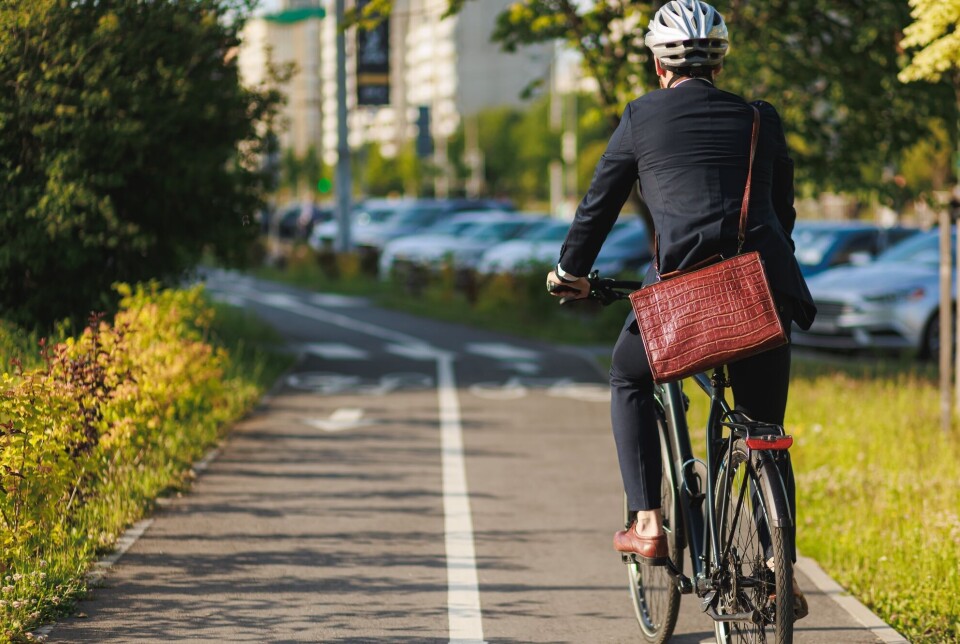THIS CONTENT IS BROUGHT TO YOU BY Oslo Metropolitan University - read more

How can we get more people to cycle?
In his new book, cycling researcher Daniel Piatkowski shows how we can get even more people out of cars and onto bikes.
Simple measures such as the use of electric bicycles, reduced speed limits, and car parking restrictions can make it easier for people to choose bicycles over cars.
These are some of the arguments presented by researcher Daniel Piatkowski in his new book.
“The research shows, for example, that electric bicycles help many Americans to leave their cars at home and choose a bike instead. No one anticipated how important electric bicycles would become,” says Piatkowski.
Everyone he interviewed in the book referred to electric bikes as a game changer, and they are right, he believes.
Electrification reduces barriers to cycling and makes e-bikes a viable alternative to cars for a significant portion of everyday trips.
“Electric bicycles are physically easier to use, and people are motivated to cycle longer. When it becomes easier to cycle a long distance, people are happy to do it. It also makes it easier for you to take the safest route to work, even if it's a bit longer,” he says.
Overcoming cycling barriers
Bicycles, including e-bikes and electric cargo bikes, can replace cars to an even greater extent over short distances.
This can be done by overcoming even more barriers to cycling, which can make cities more welcoming to people of all ages and abilities.
Here, Piatkowski uses examples from Norway's capital Oslo. Although cycling is not as widespread in Oslo as in Copenhagen and Amsterdam, Oslo has also promoted cycling well through simple measures. For example by limiting car parking in central city areas and lowering speed limits.

In this way, driving becomes less attractive, and cycling more relevant. The result is that it will be easier for people to travel, especially in the city centre, and the streets and roads are much safer for everyone.
“These were cheap measures, and quickly after Oslo implemented them, fewer cyclists and pedestrians died in traffic,” he says.
15-minute cities
There may also be talk of more advanced measures, such as building better physical cycling infrastructure in the city, building destinations that are close to each other, and perhaps developing a city where people can easily get to things by bike within 15 minutes.
15-minute cities, where people have everything they need within a 15-minute walking or cycling distance, have become much more relevant in recent years. For example in a city like Paris.
New cycling options are helping to make pedal-powered mobility a realistic, efficient option for many different people.
In his book, Piatkowski also argues that cycling as transport does not only belong in large, urban cities, but can also be done in suburbs and in rural areas.
Piatkowski encourages readers to change their perspective on cycling, showing that a successful cycling city is one where no one has to cycle, but anyone can.
‘Car-light’ cities
Piatkowski also makes a point of talking about ‘car-light’ cities instead of car-free cities.
Some people will obviously still need a car, and buses and trams will still be useful.
However, the advantage of bicycles, especially electric bicycles and electric cargo bikes, is that they can be used for many of the same purposes as cars, while being cheaper, faster, easier, and greener. And they can take you to even more places.
Climate-friendly and health-promoting
Investing in cycle-friendly infrastructure can also provide a basis for good health and mental well-being. It can also help deal with climate change.
By embracing cycling, local communities are taking an important step towards mitigating the climate crisis and creating more sustainable transit systems.
Piatkowski's book shows how quickly cycling increased during the Covid-19 pandemic, and how it spurred major changes in urban mobility that make Norwegian cities more sustainable.
The demand for bicycles increased sharply, and there was a sudden need for space to move around outdoors, where viruses could not spread so easily.
Experiences from Lincoln and Oslo
Bringing together the latest research, interviews, and case studies from around the world, Piatkowski provides information and inspiration to use bicycles as a catalyst to create a car-light future in cities of all sizes.
Piatkowski also draws on examples from his own experiences of living in such different cities as Lincoln in Nebraska and Oslo. In both cities, cycling has become more relevant.
Lincoln is a car-dependent city where it is often safest and easiest to drive for necessary errands, but it also has an impressive network of bike paths suitable for recreation, more than in many other American cities. Cycling has come more into focus, with better facilities for cycling in recent years.
Oslo has also historically been a car-dependent city, but from 2014 to 2020, cycling increased by 80 per cent. The aim is not primarily to become a cycling city, but to become a less car-dependent and more 'people-friendly' city.
E-bikes have become popular not only because of reduced speed limits and parking restrictions, but also because the city has hilly terrain.
Reference:
Piatkowski, D. 'Bicycle City: Riding the Bike Boom to a Brighter Future', Island Press, 2024. ISBN: 164283307X (Summary)
———
Read the Norwegian version of this article on forskning.no

This content is paid for and presented by OsloMet
This content is created by Oslo Metropolitan University's communication staff, who use this platform to communicate science and share results from research with the public. Oslo Metropolitan University is one of more than 80 owners of ScienceNorway.no. Read more here.
More content from OsloMet:
-
"Norwegians practice a friendship version of a ‘one-night stand'"
-
"We need to talk about how we assess teacher students"
-
Cannabis use in Norway has increased: “Not everyone needs moral lectures or worried looks"
-
Many children with ADHD do not thrive at school
-
An out-of-control race: Why we fear artificial intelligence
-
One in four seniors feels digitally discriminated against




































